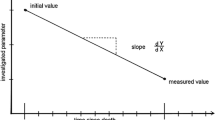Abstract
Former experiments with thermal conduction probes showed signs of reductions or increases of myocardial perfusion shortly after injection of microspheres into the left atrium. Because of this, 210 measurements made during experiments on 66 dogs under propionylpromazine/pentobarbital narcosis were newly analysed to verify a possible influence of microspheres (9 μm 0) injected into the left atrium on microcirculation. Using 20 additional dogs in identically performed experiments, the myocardial perfusion was measured using thermal conductance probes, following injections of isotonic NaCl solution (8 ml each), Ringer's solution, 5% glucose, the subject's blood, and isotonic NaCl solution mixed with the surface-active substance Tween 80®. These suspension media were injected both with and without unlabelled microspheres (8.6 μlm Q1). The results led to the following conclusions: An obligatory decrease in the blood supply as the result of a mechanical blocking of capillaries by microspheres can be ruled out. The particles, the suspension media, and a suspension temperature not sufficiently adjusted to the body temperature induce reactive negative or positive changes in the microcirculation of the myocardium. This was found in approx. 45%-75% of cases. Solutions containing particles cause, in the majority of cases, a decrease. The suspension medium with the smallest effect proved to be isotonic NaCl solution. From the results one can conclude that artefacts may arise from the application of the heat conductance probe method when the temperatures are not perfectly matched. However, the injected solution itself can often lead to various reactions in microcirculation which may last up to 5 min. It is advisable to allow at least 6 min to elapse after reactive changes have faded before administering the next injection. In no case could the effects observed using the thermal conductance probes be confirmed by another measurement parameter (ECG, heart frequency, left ventricular pressure, dp/dtmax, aortic pressure).
Similar content being viewed by others
References
Betz E, Hensel H, du Mesnil de Rochement W (1966) Simultane Messungen der lokalen Myokarddurchblutung mit Wärmeleit-messern und 85-Krypton-Clearence. Pflügers Arch 288:389–400
Buckberg GD, Luck JC, Payne DB, Hoffmann RE, Archie JP, Fixler DE (1971) Some sources of error in measuring regional blood flow with radioactive microspheres. J Appl Physiol 31:598–604
Classen GW (1983) Vergleich von Myokarddurchblutungsmessungen in Wärmeleitsonden und markierten Mikrosphären. Experimentelle Untersuchungen am narkotisierten Hund unter Verwendung des Koronartherapeutikums Oxyfedrin. Dissertation, University of Bonn
Domenech RJ, Hoffmann JIE, Nobel MIM, Saunders KB, Hensen JR, Subiganto S (1969) Total and regional coronary blood flow measured by microspheres in conscious and anaesthetized dogs. Circ Res 25:581–596
Feigl EO (1983) Coronary physiology. Physiol Rev 63:31–39
Golenhofen K, Hensel H, Hildebrandt G (1963) Durchblutungsmessung mit Wärmeleitelementen. Thieme, Stuttgart
Hahn N, Raqué B, Classen G, Kluge R, Schlich G, Biersack HJ, Felix R (1980) Die Wirkung von Oxyfedrin auf den normalen Kreislauf und bei konstant gehaltenem Aortendruck — Untersuchungen am narkotisierten Hund. I: Messungen der Durchblutung im normalen und partiell ischämischen Myokard mit markierten Mikrosphären. Herz/Kreislauf 12:397–402
Hahn N, Raqué B, Holst A, Henn I, v. Randow H, Malotki D, Oehr P, Felix R (1981) Die Wirkung von Oxyfedrin auf Hämodynamik, Inotropie und Durchblutung des partiell ischämiegeschädigten Myokards nach Prämedikation mit Digoxin. Arzneimittelforschung 31:410–414
Hahn N, Sternitzke N, Malotki D, Raqué B, Eichelkraut W, Forneck G (1985) Der Einfluß von Akrinor® auf die Hämodynamik und die Myokarddurchblutung bei partiell ischämiegeschädigtem Herzen (kardiogener Schock). Akute Versuche am narkotisierten Hund. Herz/Kreislauf 9:462–469
Hof RP (1982) Aus unseren Laboratorien: Messung der regionalen Durchblutung mit Hilfe von Tracer-Mikrosphären: eine Methode, ihre Anwendung und ihre Probleme. Triangel 21:29–36
Rudolph AM, Heymann MA (1967) The circulation of the fetus in utero. Methods for studying distribution of blood flow, cardiac output and organ blood flow. Circ Res 21:163–184
Schaper W (1979) The measurement of regional myocardial perfusion. In: Schaper W (ed) The pathophysiology of myocardial perfusion. Elsevier/North Holland, Amsterdam, New York, Oxford, p 9
Author information
Authors and Affiliations
Rights and permissions
About this article
Cite this article
Hahn, N., Eichelkraut, W. & Kropp, J. The effects of microsphere injections into the left atrium on the myocardial blood supply measured by thermal conductance probes. Eur J Nucl Med 16, 241–247 (1990). https://doi.org/10.1007/BF00842775
Received:
Revised:
Issue Date:
DOI: https://doi.org/10.1007/BF00842775




